Down and out in London, Paris, La Rochelle, and the Basque country in Bilbao : notes on Western Europe today
Oct 12th, 2014 | By Citizen X | Category: Countries of the World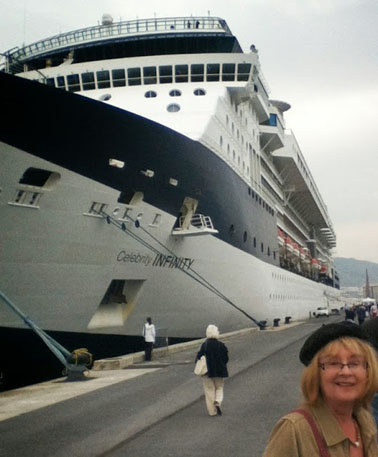 What if you had already figured out that our earlier post here (“At the Berkeley Square-Bilbao Conference – our staff hard at work in Western Europe, last half of September”) was really just about another sordid case of that early 21st century mass middle-class tourism scourge known as the cruise?
What if you had already figured out that our earlier post here (“At the Berkeley Square-Bilbao Conference – our staff hard at work in Western Europe, last half of September”) was really just about another sordid case of that early 21st century mass middle-class tourism scourge known as the cruise?
Taken by three remarkable senior sisters of French-Canadian-Scottish descent in Ontario and Atlantic Canada today? And their almost equally remarkable personal companions of later life?
What difference would it seriously make if this were true? The overwhelming big political news of the first few days – over the miniature TVs in the “staterooms” of the 2500 passengers – would still be about the latest chorus of the Barack Obama American foreign policy blues.
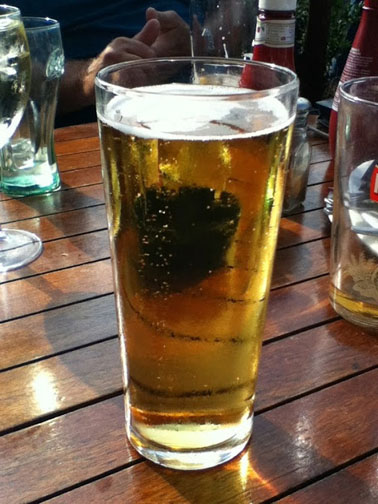
Outside the old London County Hall in Lambeth, on the banks of the Thames – in what some Canadians once saw as the global imperial metropolis.
“Men make their own history, but they do not make it just as they please; they do not make it under circumstances chosen by themselves, but under circumstances directly encountered, given and transmitted from the past. The tradition of all the dead generations weighs like a nightmare on the brain of the living.”
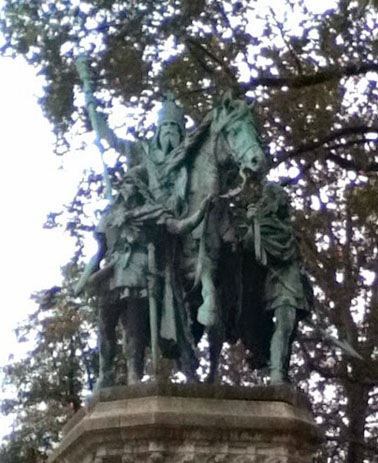
Equestrian Statue of Charlemagne (74?—814, “first emperor in western Europe since the collapse of the Western Roman Empire three centuries earlier” --- and ancient ancestor of today’s European Union) , on the grounds of Notre Dame Cathedral in Paris, September 2014.
The contest with ISIS or ISIL or just IS, and the wider world of early 21st century militant jihadist Islam actually is starting to seem like some strange revival of the Christian Crusades against Muslim domination of the Holy Lands, 1096—1270. (Or, if you prefer, 1095—1291.)
Subtlety and cunning is what American foreign policy needs most right now. Say whatever else  you like, that is what Barack Obama tries to deliver. And he succeeds more often than most of the world is still giving him credit for.
Of course there is no exact parallel with the medieval Crusades. Today’s “war on terror” is partly a replacement for yesterday’s anti-communism in the West.
It is also a reaction to the new mingling of Christians, Jews, and Muslims that has come about in Western Europe and the Middle East (and North America) since the Second World War.
As already noted in the (well, almost) last post here, secretly on the mass middle-class tourism scourge from which we’ve just returned : “Along with London, England, our … travelling … conference this year will take us to Le Havre, Paris, and La Rochelle in France, to Bilbao and Vigo in Spain, and to Porto in Portugal.”
2. On Berkeley Square
Through another windfall that one of the sisters cleverly arranged, before our cruise began we spent two days at a hotel near the corner of Berkeley Street and Piccadilly in the posh London neighbourhood of Mayfair – a locale ordinarily much beyond even the collective means of all six cruisers.
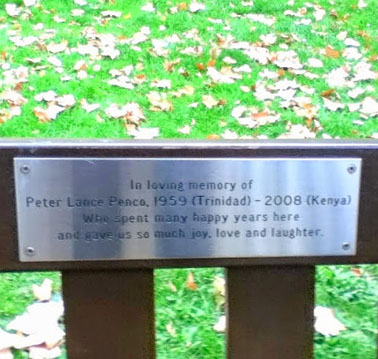 (And we can report that the legendary Berkeley Square – in which, eg, the Nightingale Sang : just north of our hotel – still exudes some mysterious urbane charm. The often emotional dedications on the park benches can bring tears to your eyes, as they also suggest something of why London remains a great world city. At the same time, some kind of tentish structure is apparently being erected – or taken down? – for some purpose in the north end of what is officially known as Berkeley Square Gardens. And I don’t much like it myself.)
(And we can report that the legendary Berkeley Square – in which, eg, the Nightingale Sang : just north of our hotel – still exudes some mysterious urbane charm. The often emotional dedications on the park benches can bring tears to your eyes, as they also suggest something of why London remains a great world city. At the same time, some kind of tentish structure is apparently being erected – or taken down? – for some purpose in the north end of what is officially known as Berkeley Square Gardens. And I don’t much like it myself.)
3. Scottish referendum results
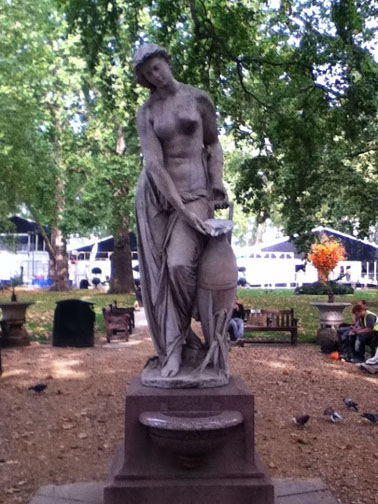
“The Woman of Samaria, created by the Pre-Raphaelite artist Alexander Munro in 1858 at the request of Henry Petty Fitzmaurice, the third Marquis of Landsdowne. The marble figure was initially positioned outside the square facing south but in 1937 was relocated looking northwards inside the garden. A few years later the fountain ceased to function.” The square here of course refers to Berkeley Square, which has countless distinctions.
We did our best to watch the Scottish referendum TV reporting on the night of September 18, 2014 from our hotel near Berkeley Street and Piccadilly.
As I recall, the first of the various geographic constitutencies (“councils”) reporting (Clackmannanshire – probably a ridiculously romantic fake name to the remarkable Englishman in NewYork, John Oliver) did suggest that the Yes side was in serious trouble before midnight.
But it was a few or even several hours into the early morning of September 19 before any clear hint of the final result for all Scotland was on TV.
On the later morning of the 19th we were on our way to the cruise ship in Harwich (nb North Americans : the Brits improbably pronounce this name something like “Hair-Edge”) by the time the final result was engraved in stone – 55.3% No to Scottish “independence,”44.7% Yes, with a very democratically impressive 84.6% voter turnout.
4. New Statesman post mortem
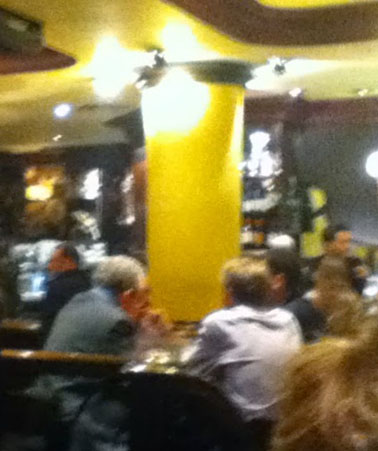 Just before watching TV, on the night of September 18, our engaging Scottish waiter in the boisterous but upscale nearby pub on Piccadilly, across from Green Park, had one clever and possibly astute thing to say. His mother in Scotland had voted Yes – but probably mostly because his father had voted No.
Just before watching TV, on the night of September 18, our engaging Scottish waiter in the boisterous but upscale nearby pub on Piccadilly, across from Green Park, had one clever and possibly astute thing to say. His mother in Scotland had voted Yes – but probably mostly because his father had voted No.
The New Statesman for 26 September—2 October 2014 (a copy of which I finally picked up at Heathrow Airport this past Wednesday, or maybe it’s the one before that now) offers post mortems from various mostly progressive hands on both sides, under such beguiling headings as:
“The View from the Lords: Time to answer the West Lothian question” (Joan Bakewell); “The Think Tanker: English devolution should be a messy affair” (Nick Pearce) ; and “The Legal View: Hasty reforms will only bolster the status quo” (Helena Kennedy). “
These are followed by : “The View from Scotland: The Union can’t withstand English nationalism” (Adam Tomkins) ; “The View from Wales: There should be home rule for all” (Carwyn Jones) ; and “The View from England: Our centralised state is undemocratic” (Jon Cruddas). Â One silly thought here : will “There’ll Always be An England” ever be the same?
5. “West Lothian Question”
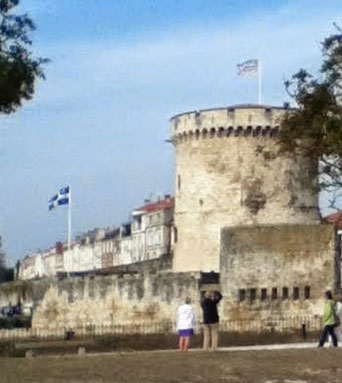
What does France think about Canada today? This Quebec flag flying in the Vieux Port district of La Rochelle is one kind of answer.
In principle, at least a version of the so-called “West Lothian question” in the UK arguably has particular interest for Canada today.
Pierre Trudeau’s fundamental objection to any form of special status for Quebec, eg, was that, if Quebec had more powers as a province than the other provinces, it couldn’t also reasonably expect the same influence as the other provinces over federal institutions and policy.
Even with the No vote on September 18, Scotland already has its own parliament, separate from the parliament of the United Kingdom. And promises have been made to give this separate parliament still more power.
But how can that be squared with the continuing powers of Scottish MPs to vote just like English MPs in matters affecting the United Kingdom at large? Â (Or, as Wikipedia has put the point :”The West Lothian question refers to whether Members of Parliament from Northern Ireland, Scotland and Wales should be able to vote on matters that affect only England in the House of Commons of the United Kingdom, given that power over selected ‘soft’ powers is devolved to regional assemblies in those areas.”)
6. “Britain is broken: how to remake the UK’s democracy …”
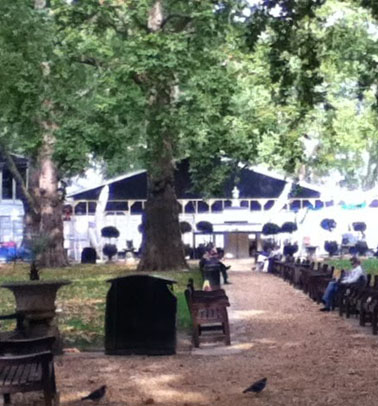
Something, some might say, probably is wrong with a Great Britain that allows the north end of Berekeley Square Gardens in London to be taken up by the transient monstrosity looming in the distance here, pretending to deserve to share space with trees planted in 1789.
There seems no simple, immediate or obvious answer to the so-called  “West Lothian question” in the UK right now.
Yet as the Scottish referendum post mortem in the New Statesman for 26 September—2 October 2014 makes clear enough, constitutionally the United Kingdom of the 21st century is (probably) at least evolving into something rather different than it used to be.
According to Nick Pearce, “director of the Institute for Public Policy Research … The evolution of the Union and England’s governance within it also have irreducibly national or Westminster dimensions, which is why it is legitimate to pose the West Lothian question, as well as consider reform of the House of Lords, a written constitution and a host of other matters. All of the main [political] parties have sectional interests at stake here – a fact that has been blindingly obvious in recent days. That is why a constitutional convention should be called: so that a rolling, democratic debate can replace partisan usurpation of the agenda.”
Mr. Pearce goes on : The constitutional convention “should mix deliberative and representative politics, as the Irish have shown is possible, and allow for wide-ranging discussions of the kind that took place in Scotland. If the political parties can’t agree to it, people should just get on with calling their own meetings … The referendum put questions of power and sovereignty at the centre of our politics – not as the arcane interests of constitutional theorists, but as burgeoning expressions of popular sentiment. The issue now is whether these energies can be mobilised for a wider reconfiguration and reform of the state, in England and the rest of the Union.”
7. Canada’s variation on the theme ????
Who knows where all this may or may not finally lead inside the UK itself?
But eventually Canadians might start to wonder how whatever it proves to be relates to the current 19th century colonial preamble to what we on this side of the Atlantic Ocean now call Canada’s Constitution Act, 1867. Â Which says that our country even today has a “Constitution similar in Principle to that of the United Kingdom.” ????
What does this Constitution similar in Principle mean, that is to say, when the Constitution of the United Kingdom itself is changing, and perhaps in some rather dramatic and intriguing ways?
8. On to the City of Light
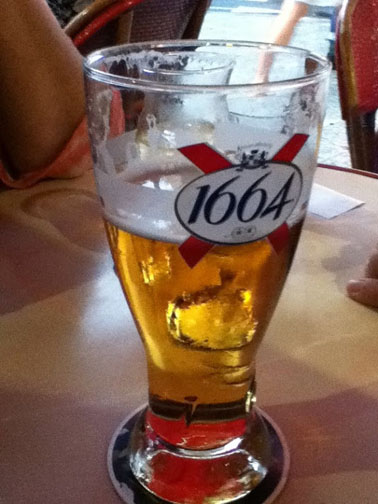
“1664 est une bière blonde de grande origine issue du savoir-faire de nos Maîtres Brasseurs depuis 1664, année au cours de laquelle Jérôme Hatt, fondateur de Brasseries Kronenbourg, a obtenu sa maîtrise de brasseur et repris la célèbre brasserie du Canon à Strasbourg. “ Also “the most sold French beer in the world” – owned by Carlsberg Group since the fateful year of 2008.
Starting on the late afternoon of the 19th, the cruise ship went from Harwich (ie “Hair-Edge”) on the English Channel to Le Havre on the north coast of France. And from Le Havre the three sisters and their companions took a train trip to the City of Light.
We even stayed in Paris overnight (Saturday 20 September) – and once again at a comfortable, elegant, and even hi-tech hotel in Montparnasse. (More or less, I think : close to the Rennes and Saint-Placide metro stations in any case – and considerably beyond the ordinary resources of those involved. Yet again one of the sisters had cleverly arranged all this, adroitly using points from a timeshare somewhere else, in Spain or Miami, or even what-money-goes-to-Vegas-stays-in-Vegas-wink-wink … something like that!)
9. That night in Montparnasse
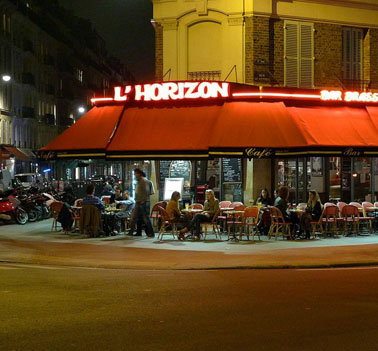
“L'Horizon, Rue de Rennes ... by Eliweisz ... Photography / Urban & Rural / City Life©2014 Eliweisz.”
In Paris that night three of us (and not all men) stayed up for a bit, drinking beer and white wine at a sidewalk café on the corner of Rue de Vaugirard and something else (Rue de Rennes?) . Someone confessed that he liked Paris more than he thought he would.
There was a mild and entertaining altercation between a haughty waiter and a courgarish lady over an unpaid bill. It ended with a visit to the ATM across the street, under police escort! (And how wonderfully civilized a place Paris must be, you thought, if the local police have nothing better to do than attend to such near-trivial human conflicts on a Saturday night!)
Meanwhile, we caught up on our lives since the last time we had drinks together on a cruise vacation. Paris really did seem to be the City of Light. Like a Hollywood movie … certainly worth the expense involved.
I should note as well that according to Wikipedia : the Montparnasse  area of Paris “is also known for cafes and bars, such as the Breton restaurants specialising in crêpes (thin pancakes) located a few blocks from the Gare Montparnasse.” And we did have crêpes for a strange kind of dinner on our night in Paris. (Nicely complemented by beer and white wine only a little while later – much closer to the hotel.)
10. Exploring La Rochelle
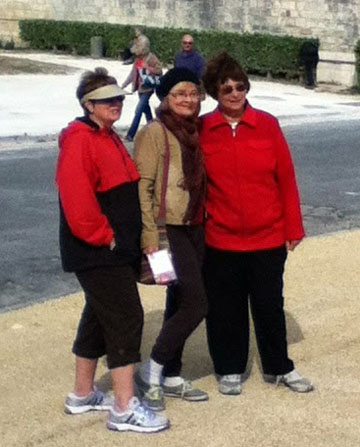 The next afternoon we went back to the cruise ship at Le Havre on a very crowded train. After some Atlantic Ocean “sailing” from Le Havre to the Bay of Biscay, the cruise ship docked next at La Rochelle – “one of the most attractive ports along France’s Atlantic coast.”
The next afternoon we went back to the cruise ship at Le Havre on a very crowded train. After some Atlantic Ocean “sailing” from Le Havre to the Bay of Biscay, the cruise ship docked next at La Rochelle – “one of the most attractive ports along France’s Atlantic coast.”
Here, an upbeat review in The Independent (a UK paper) urged back on Saturday 16 August 2008 : “Life revolves around the Vieux Port, at the entrance to which stands La Rochelle’s distinctive stone towers. The quaysides form a square around the harbour, and it’s a bustling place full of bars, restaurants … Here, the Gothic gateway of the 14th-century Porte de la Grosse Horloge leads into the old town, with its pleasing combination of arcaded streets and striking architecture that ranges from the medieval to the belle époque … The main tourist office is at 2 quai Georges Simenon, in Le Gabut on the southern side of the harbour.”
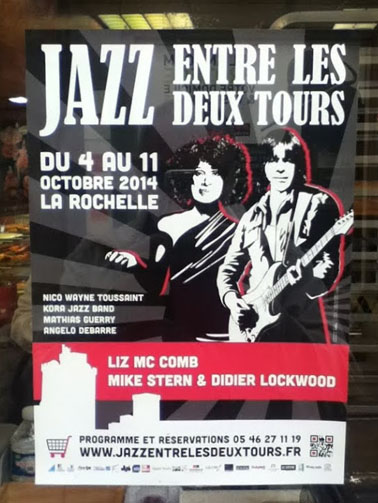 Believe it or not, we have friends in Toronto with a vacation place on ÃŽle de Ré, just adjacent to La Rochelle.  (And note that, according to Wikipedia, Samuel de Champlain, father of Canada or New France, was born either in Brouage, just a short distance south of La Rochelle, or in La Rochelle itself.) And before we left they advised us wisely about the attractions of La Rochelle and its more or less immediate environs – and the foolishness of trying to go to Bordeaux from there (as we had from Le Havre to Paris).
Believe it or not, we have friends in Toronto with a vacation place on ÃŽle de Ré, just adjacent to La Rochelle.  (And note that, according to Wikipedia, Samuel de Champlain, father of Canada or New France, was born either in Brouage, just a short distance south of La Rochelle, or in La Rochelle itself.) And before we left they advised us wisely about the attractions of La Rochelle and its more or less immediate environs – and the foolishness of trying to go to Bordeaux from there (as we had from Le Havre to Paris).
They also urged, as we parted company after a kind of bon voyage dinner, “speak French when you’re in France.” Â And even in Paris we could see the point of this remark. English seems more prominent than last time we were there, at least in the customary tourist traps inhabited by visitors like us … “Globalization/Americanization,” and all that … ?
11. “La France se mobilise face aux menaces de 1’État islamique”
In La Rochelle I also bought a copy of Le Figaro for mardi 23 septembre 2014, with the stark front-page headline : “La France se mobilise face aux menaces de 1’État islamique.” It included an insert of the six-page New York Times “International Weekly” – in English.
(Maybe there are more than one or two anglophone families who regularly visit ÃŽle de Ré? A bit like the big-box grocery stores in parts of Tuscany much loved by anglophones, that do loudspeaker announcements in Italian and English? But still …)
On what I at least see as a more traditional stereotype of France and its people since 1789, La Rochelle still has charming bookstores of a sort that have all but disappeared from where I live in Toronto, Ontario, Canada (all native North American words btw). And with the admonition to (at least try to) speak French when you’re in France still in my ears, I finally bought two books : Les 100 Mots de la Géopolitique, coordonné par Pascal Gauchon et Jean-Marc Huissoud, and first published in 2008 ; and Les Vacances de Maigret , first published in 1948 by the great if also near-monstrous-or-worse Belgian “sleazeball and creative artist,” Georges Simenon.
(Simenon, who lived in Nieul-sur-Mer just north of La Rochelle for many years, is sometimes said, no doubt with at least some exaggeration, to have had sex seven times a day! Or as Mark Lawson in The Guardian put it back in November 2002: “A remarkably prolific novelist, Simenon was also an astonishingly gushing lover. In old age, he claimed to have had sex with 10,000 women and, while all claims of erotic prowess are subject to a certain rounding-up, it’s clear he used prostitutes at the rate Parisians get through Gitanes.”)
12. Bilbao and the Basque Country in Spain
I am already almost out of space here. And I have yet to report on what many among the three-sisters group saw as the most striking stop on the entire cruise – in Bilbao, cultural capital of the autonomous community of the Basque Country in Spain.
I first heard of Bilbao myself many years ago, via a Lotte Lenya recording of the “Bilbao Song” by Kurt Weil and Bertolt Brecht. (Here in a North Americanized version of the early 1960s by Andy Williams – with English lyrics by Johnny Mercer ; here in the original German of the late 1920s by Lotte Lenya ; here in a North Americanized update of the original by Marianne Faithfull ; and here in a quite recent update of the original German classic by Ute Lemper.)
Bilbao today is noted for Frank Gehry’s Guggenheim Museum : “Instantly hailed as the most important structure of its time,” it has now “celebrated more than a decade [about 17 years in the autumn of 2014 in fact] of extraordinary success. With over a hundred exhibitions and more than ten million visitors to its credit, the Guggenheim Museum Bilbao has changed the way people think about museums, and it continues to challenge assumptions about the connections between art, architecture, and collecting.”
As in other Spanish cities, older and more ordinary architecture and public-space landscaping in Bilbao is also quite striking. (And some of this seems to date from a rebuilding of the city in the 1940s, after the depredations of the Spanish Civil War.)
More compellingly again, in an age of Scottish referendums and Quebec flags in old French seaports with ties to Samuel de Champlain, the Father of Canada or New France, the 1-million + people of Bilbao today live in the metropolis of the Basque Country. And the Basque Country is an old European “mini-nation” that straddles the border between modern France and Spain. Intriguingly enough, the Bilbao-centred part of the region has achieved some formal political expression as an autonomous community under the new Spanish constitution of 1978, drafted and approved by the Constituent Cortes (or Spanish Parliament, in its capacity as a constitutional assembly) after the death of Francisco Franco in 1975.
Like La Rochelle, Bilbao is also a Bay of Biscay seaport with longstanding ties to the ancient cod fisheries of the Grand Banks, off the coast of Atlantic Canada. To the 2014 tourist’s naked eye, it seems quite prosperous as well. And this raises questions about just what has been happening in the place over the past quarter century or more.
 Bilbao’s industrialization since the later 19th century had a lot to do with nearby Basque Country iron mines . And a 2012 German article explained how : “In the 1970s, Bilbao was one of the most polluted cities in the world, as smog from its mines and furnaces mingled with the humid Basque air. Today, there is still industry, but tourism is now driving Bilbao’s economy, with all the related services and revenue that one million visitors per year generate … The ‘Guggenheim effect’ not only made Bilbao prosperous, it made it cool.” (Though there remains something of a nasty smell to the Bilbao River, as a reminder of the most polluted 1970s. And Bilbao today is logically enough twinned with the reviving old steeltown of Pittsburgh in the USA.)
Bilbao’s industrialization since the later 19th century had a lot to do with nearby Basque Country iron mines . And a 2012 German article explained how : “In the 1970s, Bilbao was one of the most polluted cities in the world, as smog from its mines and furnaces mingled with the humid Basque air. Today, there is still industry, but tourism is now driving Bilbao’s economy, with all the related services and revenue that one million visitors per year generate … The ‘Guggenheim effect’ not only made Bilbao prosperous, it made it cool.” (Though there remains something of a nasty smell to the Bilbao River, as a reminder of the most polluted 1970s. And Bilbao today is logically enough twinned with the reviving old steeltown of Pittsburgh in the USA.)
My own immediate takeaway from our two days in Bilbao and its seaside suburb of Getxo (formerly spelled Guecho) is that this is a place I should know more about. Its current apparent prosperity (to the naked eye) can’t all be a result of tourism drawn by Frank Gehry’s Guggenheim Museum Bilbao, “inaugurated on October 18, 1997.” What is the deeper and wider story?
13. Remembering the Portuguese Pioneers
At least the stopover part of our cruise ended in the old Portruguese seaport of Porto. As explained by Wikipedia : “Porto (Portuguese pronunciation: [‘po?tu]) (occasionally also known as Oporto in English) is the second-largest city in Portugal, after Lisbon, and one of the major urban areas in Southern Europe and the capital of the second major great urban area in Portugal.”
The random anonymous authorities go on : “Porto is one of the oldest European centres, and [was] registered as a World Heritage Site by UNESCO in 1996. Its settlement dates back many centuries, when it was an outpost of the Roman Empire … In the 14th and the 15th centuries, Porto’s shipyards contributed to the development of Portuguese shipbuilding. It was also from the port of Porto that, in 1415, Prince Henry the Navigator (son of John I of Portugal) embarked on the conquest of the Moorish port of Ceuta, in northern Morocco. This expedition by the King and his fleet, which counted among others Prince Henry, was followed by navigation and exploration along the western coast of Africa, initiating the Portuguese Age of Discovery.”
The Portuguese Age of Discovery went on to include Bartholomew Diaz’s “first European” voyage around the southernmost tip of Africa in 1488, and then Vasco da Gamma’s achievement of the ultimate prize sought by Prince Henry more than 80 years before, when he landed at Calicut in India on May 20, 1498. So, according to a present-day website, “ the Portuguese of the 15th and 16th centuries become the Pioneers of Globalization.” (And this theme was elaborated on as long ago as 1933 by Edgar Prestage in his still extant classic, The Portuguese Pioneers. Much more recently see also Jorge Nascimento Rodrigues and Tessaleno Devezas, Pioneers of Globalization : Why the Portuguese surprised the World .)
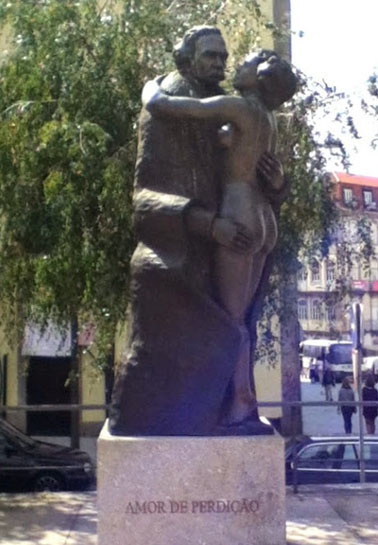 What I can tell you about Porto today, myself, is that it does seem a very old place (especially in its older areas where tourists go), relieved by various flashes of modernity. It may rival San Francisco as a seaside city of hills as well. And the most intriguing thing I saw in my short time there is described in an official web document as follows :
What I can tell you about Porto today, myself, is that it does seem a very old place (especially in its older areas where tourists go), relieved by various flashes of modernity. It may rival San Francisco as a seaside city of hills as well. And the most intriguing thing I saw in my short time there is described in an official web document as follows :
“The statue ‘Amor de Perdição’, by Mestre Francisco Simões, located at the Largo Amor de Perdição (Campo Mártires da Pátria), was … inaugurated by the Mayor of Porto, Rui Rio [in 2012]. The statue is a tribute to one of the best and most prolific writers in Portuguese literature, Camilo Castelo Branco, author of the novel “Amor de Perdição”, from 1862, a man of intense passions. I[t] was indeed his passion for Ana Plácido that convicted the couple to a prison sentence in the jail that is now the Portuguese Centre for Photography, in a time in which adulterous love was considered to be a crime.”
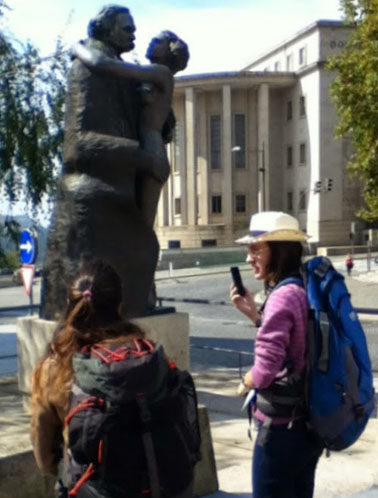 It was only later, back in North America, that we came to know all this. In Porto at the  Largo Amor de Perdição one of the three sisters’ personal companions on our trip (with me, as another of the genre, right beside him) asked a visiting female student engineer from Brazil (who happily spoke English as well as Portuguese – and Spanish) just what “Amor de Perdição” means. She apparently did not know about the Camilo Castelo Branco novel either. She was just thinking about the Portuguese words. After quite a long meditation, she said “It means a very strong love.”
It was only later, back in North America, that we came to know all this. In Porto at the  Largo Amor de Perdição one of the three sisters’ personal companions on our trip (with me, as another of the genre, right beside him) asked a visiting female student engineer from Brazil (who happily spoke English as well as Portuguese – and Spanish) just what “Amor de Perdição” means. She apparently did not know about the Camilo Castelo Branco novel either. She was just thinking about the Portuguese words. After quite a long meditation, she said “It means a very strong love.”
14. Meanwhile, back in India and China today
From Porto we were two days cruising “at sea,” back to our original point of departure at  Harwich (ie “Hair-Edge”) on the English Channel. It was time enough to reflect on the instant travelling of the previous 10 (or  was it 11 or even 12?) days.
I came back, as in other times in Europe over the past while, to a piece called “Toward European Unity” published by George Orwell in the July-August 1947 issue of the New York little magazine, Partisan Review. Â I returned in particular to two sentences toward the end of this piece : “It may be that Europe is finished and that in the long run some better form of society will arise in India or China. But I believe that it is only in Europe, if anywhere, that democratic Socialism could be made a reality in short enough time to prevent the dropping of the atom bombs.”
In the early autumn of 2014 we can see that, happily, something has prevented the dropping of the atom bombs over the past 67 years. And the European Union (of the blue flag with the circle of gold stars) and especially the 18 countries of the eurozone currency region actually may be at least closer to what Orwell would have seen as a democratic Socialist society than any other part of the world today.
Put another way, at least the continent of Europe is not quite so much a slave of a resurgent 19th century Anglo-Saxon free market ideology as the United States (and even, as George Orwell would no doubt NOT be pleased to see, the United Kingdom).
Meanwhile both India and China – which have recently made something of the enormous progress Orwell was shrewdly entertaining for them already in the late 1940s – are in some turmoil at the moment. India and Pakistan are once again at odds, under a new Hindu nationalist prime minister (and a Pakistan very mixed up in all manner of jihadist tensions). And the pro-democracy students in Hong Kong are at least raising some internal voices, against the authoritarian political culture in what is still calling itself the Peoples’ Republic of China.
Things of this sort do make clear that Europe and especially Western Europe is no longer the centre of the global village. And some are understandably concerned about such key current headlines as “Unprecedented in France: Front National’s Le Pen tops presidential poll for first time” and “Farage says UKIP could hold balance of power in 2015” (where UKIP is more or less the UK right-wing equivalent of the crypto-fascist Front National in France). But I keep thinking that, despite all the real and alleged problems we too often hear about in our anglophone media, Europe today remains an intriguing place with some admirable human commitments.
(And I take it that at least some of this more optimistic view is reflected in Benjamin Friedman’s current New York Review of Books piece on “The Pathology of Europe’s Debt.”)
George Orwell might make something a little different out of Down and Out in Paris and London today (to say nothing of Bilbao and the Basque Country). Who knows? The ever-present and much-argued-about ghost of Orwell might even feel that some of his hopes for European Unity in 1947 have now been more or less been realized. Almost as much as such things ever do come to life in the real world ????
15. “The two most successful leaders in contemporary western politics are Angela Merkel and Stephen Harper” !!!! (and returning to the Ford Nation in Toronto)
I was on the plane ride back to Toronto, Ontario, Canada for not much more than an hour, when I stumbled across a few sentences in the 26 September —2 October 2014 issue of the New Statesman from the UK that made me suddenly sit up.
They came towards the end of a David Runciman article called “An unheroic age: why do our politicians seem so diminished? …  Are our politicians getting smaller, or is it that politics is not as big as it used to be?”.  Runciman is an English academic who commands respect, in one way or another, and  he suddenly proclaimed that : “The two most successful leaders in contemporary western politics are Angela Merkel and Stephen Harper, neither of whom is famous for having an extensive hinterland (Merkel likes football, Harper likes ice hockey). Both have been subject to widespread disdain for their perceived lack of broader political vision, but both have ridden out the mockery.”
What ???? You have to be kidding, brother (cousin-once-removed etc) Runciman. Stephen Harper is one of the “two most successful leaders in contemporary western politics” ????  Have you looked at any domestic polls on PM Harper lately? (Even if it is all too true that he cleverly stranded both the federal Liberals and New Democrats on the issue of helping Barack Obomber in the fight against the Islamic State, etc, etc, etc, etc.) Maybe “the West” just isn’t what it used to be either! (Certainly this is true enough  ….  but is the West really that bad now ????)
So … 2015 will be an election year in both the United Kingdom and Canada. The UK election will it seems be in the spring, and Canada’s (most likely??) not until the fall (though, for dead certain, maybe, maybe not). But both will be interesting elections, in perhaps somewhat strange ways. To get ready, we Torontonians will also, in just two more weeks (on Monday, October 27, 2014) get to vote against the current incarnation of the Ford Nation as Mayor of Toronto. Or not. And just thinking about not thinking about this gives me a near-migraine headache already.
And I start to remember. How nice it used to be. Getting up for breakfast on the boat. Anything you can imagine wanting was there …. including the luscious dancers from the show in the theatre the night before (well, I saw one of them once, I think, in a very cute dress, but maybe that was just at the back of the theatre)… international travel for the mass middle class indeed.
And again you can’t help but wonder. What would George Orwell make of that ???? What would he have thought if he went on a cruise to Spain, instead of fighting in the Spanish Civil War ????
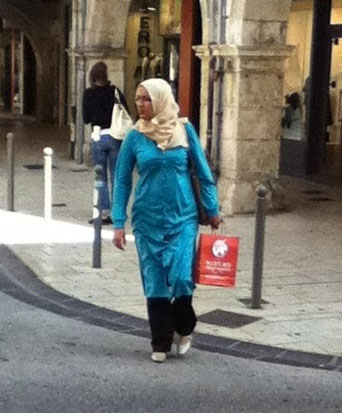

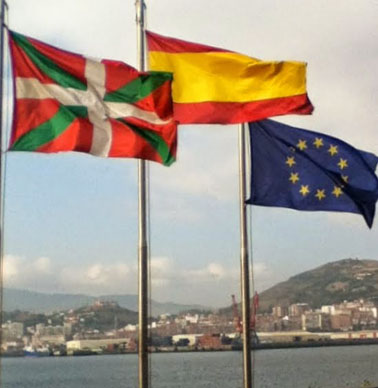
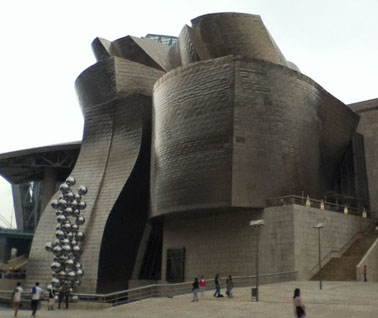
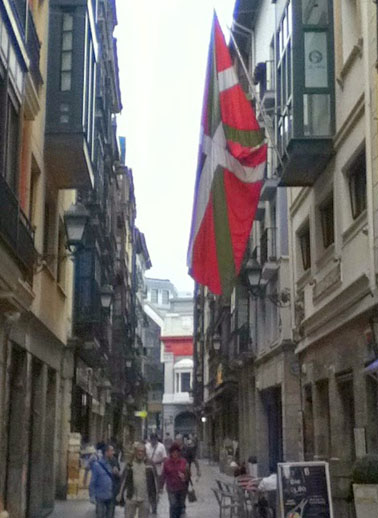
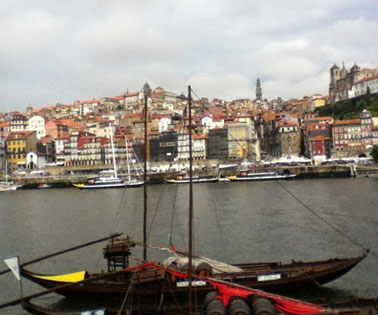
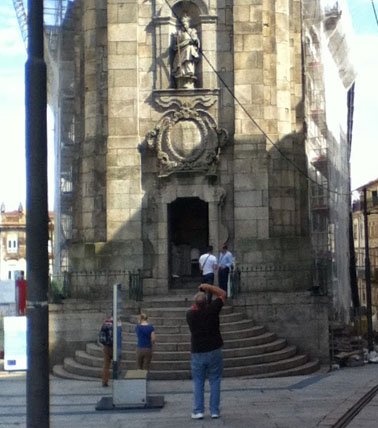
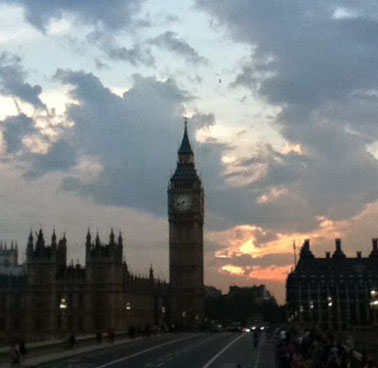

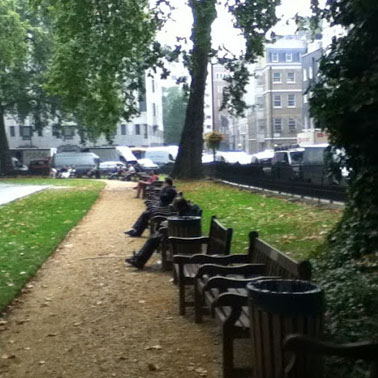
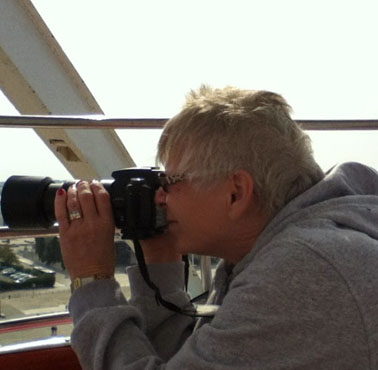

[…] In the 1970s, Bilbao was one of the most polluted cities in the world, as smog from its mines and furnaces mingled with the humid Basque air. Today, there is still industry, but tourism is now driving Bilbao’s economy, with all the related services and revenue that one million visitors per year generate … The ‘Guggenheim effect’ not only made Bilbao prosperous, it made it cool.” (Though there remains something of a nasty smell to the Bilbao River, as a reminder of the most polluted 1970s. And Bilbao today is logically enough twinned with the reviving old steeltown of Pittsburgh in the USA.) […]